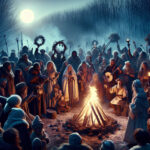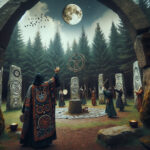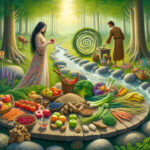The ancient pagan gods were revered by many cultures throughout history and were believed to be responsible for the natural cycles of life. From the Greek gods to the Norse gods, these powerful figures have been the subject of many stories and myths. This article will provide a comprehensive list of pagan gods, their powers, and their histories. We will explore the fascinating world of these ancient deities and how they shaped the beliefs of those who believed in them. So, let’s dive in and learn more about the pantheon of pagan gods.
The term Paganism refers to a wide variety of ancient religious beliefs and practices, often linked to the worship of nature and natural forces. While many people think of Paganism as a monolithic religion, it is actually a diverse and ever-evolving set of beliefs and practices, with different traditions and pantheons. The gods and goddesses of ancient Pagan religions are often referred to as “Pagan gods” or “Pagan goddesses. Here is a list of some of the most prominent Pagan gods and goddesses.
Aphrodite
Aphrodite is the Greek goddess of love and beauty. She is often portrayed as a beautiful woman, surrounded by flowers and other symbols of love and beauty. Aphrodite is associated with fertility, passion, and desire, and is often invoked in spells and rituals related to love and relationships.
Odin
Odin is the chief god in Norse mythology. He is often depicted as a wise old man with one eye, wearing a wide brimmed hat and a cloak. Odin is associated with magic, wisdom, and prophecy. He is often invoked in rituals related to knowledge, wisdom, and power.
Isis
Isis is an Egyptian goddess associated with motherhood, fertility, healing, and magic. She is often depicted as a woman wearing a headdress in the shape of a throne. Isis is often invoked in rituals related to childbirth, fertility, healing, and protection.
Brigid
Brigid is an Irish goddess associated with fire, smithcraft, and healing. She is often depicted as a beautiful woman with red hair and a fiery temper. Brigid is associated with creativity, inspiration, and healing, and is often invoked in rituals related to creativity, healing, and protection.
Pan
Pan is the Greek god of the wild, often depicted as a half-man, half-goat creature. He is associated with nature, music, and fertility, and is often invoked in rituals related to nature, music, and fertility.
Hecate
Hecate is a Greek goddess associated with magic, witchcraft, and the underworld. She is often depicted as a woman with three heads, and is associated with the moon, the night, and the dead. Hecate is often invoked in rituals related to magic, witchcraft, and protection.
Loki
Loki is a Norse god associated with mischief and chaos. He is often depicted as a trickster figure, and is associated with fire and magic. Loki is often invoked in rituals related to chaos, transformation, and manipulation.
Freya
Freya is a Norse goddess associated with love, beauty, and fertility. She is often depicted as a beautiful woman wearing a necklace made from pieces of the sun and the moon. Freya is associated with love, beauty, and fertility, and is often invoked in rituals related to love and fertility.
Thor
Thor is the Norse god of thunder and storms. He is often depicted as a powerful warrior wielding a hammer, and is associated with strength, courage, and protection. Thor is often invoked in rituals related to protection, strength, and courage.
Cerridwen
Cerridwen is a Welsh goddess associated with knowledge, magic, and transformation. She is often depicted as a woman with a cauldron, and is associated with healing, knowledge, and transformation. Cerridwen is often invoked in rituals related to knowledge, magic, and transformation.
Baldur
Baldur is a Norse god associated with light, beauty, and purity. He is often depicted as a handsome and gentle man, and is associated with love, peace, and harmony. Baldur is often invoked in rituals related to love, peace, and harmony.
Kali
Kali is a Hindu goddess associated with death, destruction, and transformation. She is often depicted as a dark-skinned woman with four arms, and is associated with power, transformation, and liberation. Kali is often invoked in rituals related to death, destruction, and transformation.
Lugh
Lugh is an Irish god associated with the sun, justice, and knowledge. He is often depicted as a young man with a spear, and is associated with courage, creativity, and healing. Lugh is often invoked in rituals related to justice, creativity, and healing.
Hermes
Hermes is the Greek god of commerce, communication, and travel. He is often depicted as a young man with wings on his feet, and is associated with communication, luck, and trickery. Hermes is often invoked in rituals related to communication, luck, and travel.
Dionysus
Dionysus is the Greek god of wine, pleasure, and ecstasy. He is often depicted as a young man with a grapevine in his hand, and is associated with joy, passion, and revelry. Dionysus is often invoked in rituals related to pleasure, joy, and ecstasy.
Hera
Hera is the Greek goddess of marriage and childbirth. She is often depicted as a beautiful woman wearing a crown, and is associated with loyalty, family, and fertility. Hera is often invoked in rituals related to marriage, family, and fertility.
Conclusion
While this list is by no means exhaustive, it provides a glimpse into the rich and varied pantheon of Pagan gods and goddesses. From Aphrodite to Hera, these deities have been worshiped and invoked by people around the world for thousands of years. Whether you are new to Paganism or have been practicing for a while, taking the time to learn about these deities can help you deepen your understanding of Pagan beliefs and practices.

The list of pagan gods is an important reminder of the rich and diverse history of paganism. It is a testament to the many different spiritual beliefs that have been held throughout the ages. While some of these gods may have faded from the collective consciousness, their influence on our culture and our beliefs is still evident in many ways. It is important to remember that paganism is not a single unified belief system, but rather a collection of many different beliefs and practices. As such, it is important to take the time to learn about the many different gods and goddesses that make up the pagan pantheon and to appreciate the diversity of beliefs that have been held throughout history.
In conclusion, the list of pagan gods serves as a reminder of the many different gods and goddesses that have been part of our spiritual history. It is important to recognize the diversity of beliefs and practices that have been held by different pagan cultures throughout history and to appreciate the many different ways in which paganism has influenced our culture and our beliefs.





